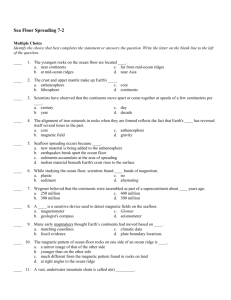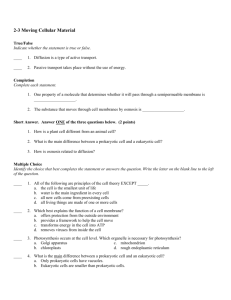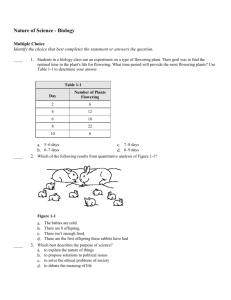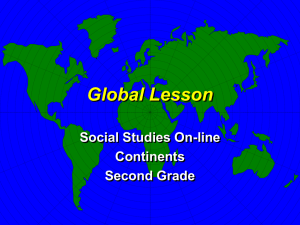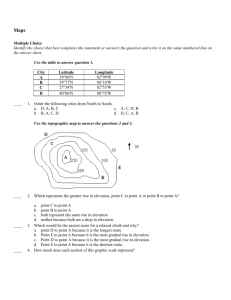7-1 Continental Drift Hypothesis test and answers
advertisement
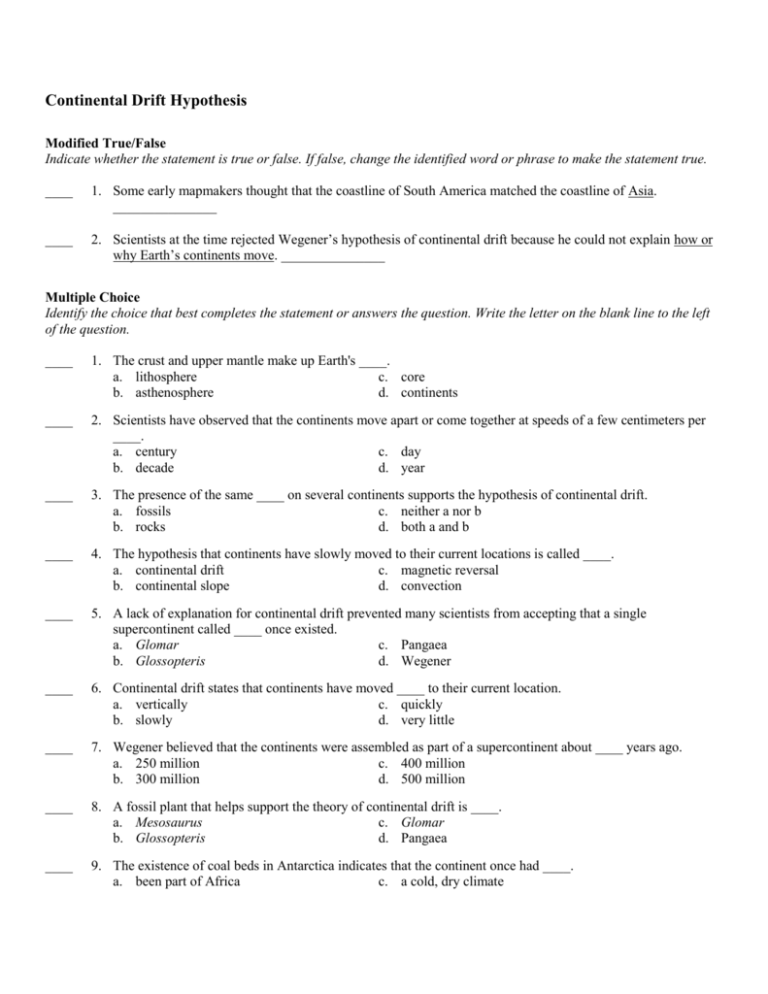
Continental Drift Hypothesis Modified True/False Indicate whether the statement is true or false. If false, change the identified word or phrase to make the statement true. ____ 1. Some early mapmakers thought that the coastline of South America matched the coastline of Asia. _______________ ____ 2. Scientists at the time rejected Wegener’s hypothesis of continental drift because he could not explain how or why Earth’s continents move. _______________ Multiple Choice Identify the choice that best completes the statement or answers the question. Write the letter on the blank line to the left of the question. ____ 1. The crust and upper mantle make up Earth's ____. a. lithosphere c. core b. asthenosphere d. continents ____ 2. Scientists have observed that the continents move apart or come together at speeds of a few centimeters per ____. a. century c. day b. decade d. year ____ 3. The presence of the same ____ on several continents supports the hypothesis of continental drift. a. fossils c. neither a nor b b. rocks d. both a and b ____ 4. The hypothesis that continents have slowly moved to their current locations is called ____. a. continental drift c. magnetic reversal b. continental slope d. convection ____ 5. A lack of explanation for continental drift prevented many scientists from accepting that a single supercontinent called ____ once existed. a. Glomar c. Pangaea b. Glossopteris d. Wegener ____ 6. Continental drift states that continents have moved ____ to their current location. a. vertically c. quickly b. slowly d. very little ____ 7. Wegener believed that the continents were assembled as part of a supercontinent about ____ years ago. a. 250 million c. 400 million b. 300 million d. 500 million ____ 8. A fossil plant that helps support the theory of continental drift is ____. a. Mesosaurus c. Glomar b. Glossopteris d. Pangaea ____ 9. The existence of coal beds in Antarctica indicates that the continent once had ____. a. been part of Africa c. a cold, dry climate b. a temperate, rainy climate d. been farther from the equator ____ 10. ____ is a fossil fern that helped support Wegener’s hypothesis of continental drift. a. Gondwanaland c. Mesosaurus b. Kannemeyerid d. Glossopteris ____ 11. Many early mapmakers thought Earth’s continents had moved based on ____. a. plate boundary locations c. climatic data b. fossil evidence d. matching coastlines Matching Match each term with the correct statement below. a. mantle c. continents b. plate tectonics d. lithosphere ____ 1. Alfred Wegener believed that the ______ were once joined. ____ 2. The crust and upper mantle make up the _____. Short Answer 1. Point out two changes that occur between the 65 mya time period and the present. (2 points) ________________________________________________________________________________________ ________________________________________________________________________________________ _______________________________________________________________________________________ 2. Alfred Wegener developed the idea that the continents move slowly over time. First, identify and describe three of the pieces of evidence Wegener used to support his hypothesis. Then, explain why other scientist did not accept his hypothesis. (4 points) ________________________________________________________________________________________ ________________________________________________________________________________________ ________________________________________________________________________________________ ________________________________________________________________________________________ ________________________________________________________________________________________ ________________________________________________________________________________________ ________________________________________________________________________________________ ________________________________________________________________________________________ ________________________________________________________________________________________ Continental Drift Hypothesis Answer Section MODIFIED TRUE/FALSE 1. ANS: F, Africa PTS: REF: STA: 2. ANS: REF: STA: 1 DIF: Bloom's Level 2 | DOK 1-LOW To review this topic refer to Plate Tectonics: Lesson 1 5.4.6.D.2 | 5.4.6.B.3 T PTS: 1 To review this topic refer to Plate Tectonics: Lesson 1 5.4.6.D.2 | 5.4.6.B.3 OBJ: 7-1 DIF: Bloom's Level 2 | DOK 1-LOW OBJ: 7-2 MULTIPLE CHOICE 1. ANS: A The cold and rigid outermost rock layer is called the lithosphere. It is made up of the crust and the solid, uppermost mantle. PTS: 1 DIF: Bloom's Level 1 | DOK 1-LOW REF: To review this topic refer to Plate Tectonics: Lesson 3 OBJ: 7-5 STA: 5.4.6.B.1 | 5.4.6.D.1 2. ANS: D Continents move apart or come together at speeds of a few centimeters per year. PTS: 1 DIF: Bloom's Level 1 | DOK 1-LOW REF: To review this topic refer to Plate Tectonics: Lesson 3 OBJ: 7-6 STA: 5.4.8.D.2 3. ANS: D Fossils of similar organisms have been found on several continents separated by oceans. If you could superimpose similar rock types onto the maps, these rocks would be in the area where Africa and South America fit together. PTS: 1 DIF: Bloom's Level 1 | DOK 1-LOW REF: To review this topic refer to Plate Tectonics: Lesson 1 OBJ: 7-1 STA: 5.4.6.D.2 | 5.4.8.D.2 4. ANS: A Wegener proposed the hypothesis of continental drift, which suggested that continents are in constant motion on the surface of Earth. PTS: 1 DIF: Bloom's Level 1 | DOK 1-LOW REF: To review this topic refer to Plate Tectonics: Lesson 1 OBJ: 7-2 STA: 5.4.6.D.2 | 5.4.8.D.2 5. ANS: C Over time Pangaea began breaking apart, and the continents slowly moved to their present positions. PTS: 1 DIF: Bloom's Level 1 | DOK 1-LOW REF: To review this topic refer to Plate Tectonics: Lesson 1 OBJ: 7-2 STA: 5.4.6.D.2 | 5.4.8.D.2 6. ANS: B Over time Pangaea began breaking apart, and the continents slowly moved to their present positions. PTS: 1 DIF: Bloom's Level 1 | DOK 1-LOW REF: To review this topic refer to Plate Tectonics: Lesson 1 OBJ: 7-2 STA: 5.4.8.D.2 7. ANS: A When Wegener pieced Pangaea together, he proposed that South America, Africa, India, and Australia were located closer to the South Pole 250 million years ago. PTS: 1 DIF: Bloom's Level 1 | DOK 1-LOW REF: To review this topic refer to Plate Tectonics: Lesson 1 OBJ: 7-2 STA: 5.4.8.D.2 8. ANS: B Fossils of Glossopteris have been found on many continents that are now separated by oceans. PTS: 1 DIF: Bloom's Level 1 | DOK 1-LOW REF: To review this topic refer to Plate Tectonics: Lesson 1 OBJ: 7-1 STA: 5.4.6.B.1 9. ANS: B Antarctica must have been warmer and wetter when these plants were alive. PTS: 1 DIF: Bloom's Level 2 | DOK 1-LOW REF: To review this topic refer to Plate Tectonics: Lesson 1 OBJ: 7-1 STA: 5.4.6.D.1 | 5.4.8.D.2 10. ANS: D Fossils of Glossopteris have been found on many continents that are now separated by oceans. PTS: 1 DIF: Bloom's Level 2 | DOK 1-LOW REF: To review this topic refer to Plate Tectonics: Lesson 1 OBJ: 7-1 STA: 5.4.6.D.1 | 5.4.8.D.2 11. ANS: D Hundreds of years ago mapmakers noticed this jigsaw-puzzle pattern as they made the first maps of the continents. PTS: 1 DIF: Bloom's Level 2 | DOK 1-LOW REF: To review this topic refer to Plate Tectonics: Lesson 1 STA: 5.4.6.B.3 | 5.4.6.D.2 OBJ: 7-1 MATCHING 1. ANS: REF: STA: 2. ANS: REF: STA: C PTS: 1 DIF: Bloom's Level 2 | DOK 1-LOW To review this topic refer to Plate Tectonics: Lesson 1 OBJ: 7-1 5.4.6.C.3 | 5.4.6.D.1 | 5.4.8.D.2 D PTS: 1 DIF: Bloom's Level 2 | DOK 1-LOW To review this topic refer to Plate Tectonics: Lesson 3 OBJ: 7-7 5.4.6.C.3 | 5.4.6.D.1 | 5.4.8.D.2 SHORT ANSWER 1. ANS: India has collided with Asia to form the Himalayas. Australia has separated from Antarctica. A rift valley is forming in east Africa. PTS: 1 DIF: Bloom's Level 4 | DOK 2-MOD REF: To review this topic refer to Plate Tectonics: Lesson 1 OBJ: 7-1 2. ANS: Evidence that Wegener used to support his theory included the way that the continents seemed to fit together like puzzle pieces, the location of similar fossils on separate continents, the presence of fossils from differing climatic conditions than were currently present in an area, and the presence of similar rock structures found on different continents. The one piece of information Wegener lacked that might have led more people to believe his idea was the explanation of the process or mechanism that moves the continents. PTS: 1

